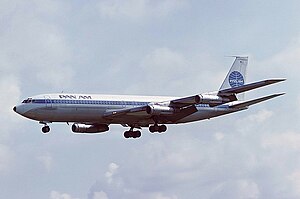
Back Boeing 707 Afrikaans Boeing 707 AN بوينغ 707 Arabic Boeing 707 AST Боинг 707 Bulgarian বোয়িং ৭০৭ Bengali/Bangla Boeing 707 BS Boeing 707 Catalan Boeing 707 Czech Boeing 707 Danish
| Boeing 707 | |
|---|---|

| |
| A low-wing, four-engined jet aircraft, the 707 was introduced into service by Pan Am in 1958. | |
| Role | Narrow-body airliner |
| National origin | United States |
| Manufacturer | Boeing Commercial Airplanes |
| First flight | December 20, 1957[1] |
| Introduction | October 26, 1958, with Pan Am |
| Status | In military service[a] |
| Primary users | Pan Am |
| Produced | 1956–1978[b] |
| Number built | 865 (excludes Boeing 720s)[4] |
| Developed from | Boeing 367-80 |
| Variants | |
| Developed into | |
The Boeing 707 is an early American long-range narrow-body airliner, the first jetliner developed and produced by Boeing Commercial Airplanes. Developed from the Boeing 367-80 prototype first flown in 1954, the initial 707-120 first flew on December 20, 1957. Pan Am began regular 707 service on October 26, 1958. With versions produced until 1979, the 707 was a swept wing quadjet with podded engines. Its larger fuselage cross-section allowed six-abreast economy seating, retained in the later 720, 727, 737, and 757 models.
Although it was not the first commercial jetliner in service, the 707 was the first to be widespread, and is often credited with beginning the Jet Age.[5] It dominated passenger air transport in the 1960s, and remained common through the 1970s, on domestic, transcontinental, and transatlantic flights, as well as cargo and military applications. It established Boeing as a dominant airliner manufacturer with its 7x7 series. The initial, 145-foot-long (44 m) 707-120 was powered by Pratt & Whitney JT3C turbojet engines. The shortened, long-range 707-138 and the more powerful 707-220 entered service in 1959. The longer-range, heavier 707-300/400 series has larger wings and is stretched slightly by 8 feet (2.4 m). Powered by Pratt & Whitney JT4A turbojets, the 707-320 entered service in 1959, and the 707-420 with Rolls-Royce Conway turbofans in 1960.
The 720, a lighter short-range variant, was also introduced in 1960. Powered by Pratt & Whitney JT3D turbofans, the 707-120B debuted in 1961 and the 707-320B in 1962. The 707-120B typically flew 137 passengers in two classes over 3,600 nautical miles [nmi] (6,700 km; 4,100 mi), and could accommodate 174 in one class. With 141 passengers in two classes, the 707-320/420 could fly 3,750 nmi (6,940 km; 4,320 mi) and the 707-320B up to 5,000 nmi (9,300 km; 5,800 mi). The 707-320C convertible passenger-freighter model entered service in 1963, and passenger 707s have been converted to freighter configurations. Military derivatives include the E-3 Sentry airborne reconnaissance aircraft and the C-137 Stratoliner VIP transport. In total, 865 Boeing 707s were produced and delivered, not including 154 Boeing 720s.
- ^ "Boeing 707 Jet Transport." aviation-history.com. Retrieved December 27, 2009.
- ^ "Iranian airline SAHA halts operation due to outdated fleet". payvand.com. Archived from the original on March 14, 2021. Retrieved April 1, 2015.
- ^ Waldron, Greg (January 14, 2019). "Boeing 707 crashes near Tehran". FlightGlobal. Retrieved January 15, 2019.
- ^ "707 Model Summary". Boeing Commercial Airplanes. Archived from the original on September 4, 2015. Retrieved December 10, 2010.
- ^ Wilson, Stewart (1999). Airliners of the World. Fyshwick, Australia: Aerospace Publications. p. 13. ISBN 978-1-875671-44-1.
The Boeing 707, the airliner which introduced jet travel on a large scale
and p. 48. Quote: "The USA's first jetliner, the 707 was at the forefront of jet travel revolution..."
Cite error: There are <ref group=lower-alpha> tags or {{efn}} templates on this page, but the references will not show without a {{reflist|group=lower-alpha}} template or {{notelist}} template (see the help page).
© MMXXIII Rich X Search. We shall prevail. All rights reserved. Rich X Search